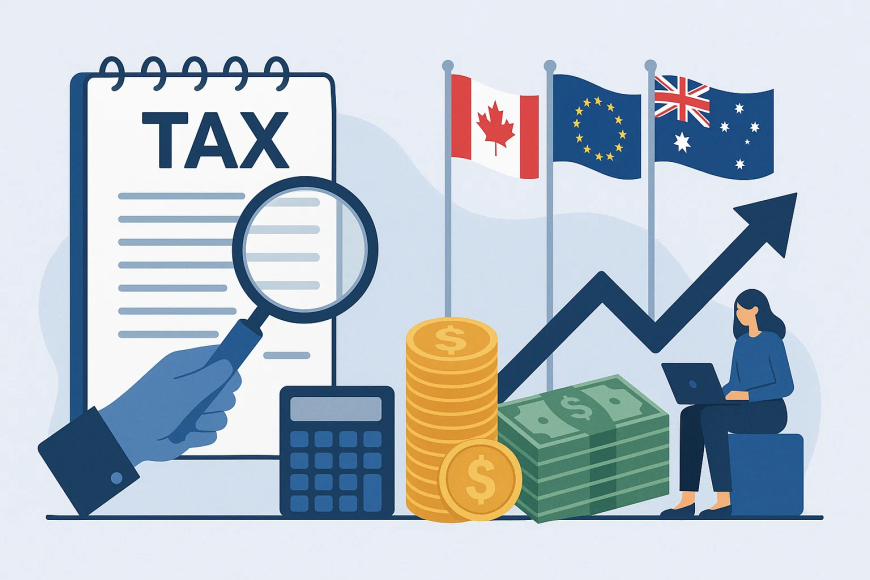Taxes in Tier-1 Countries: Comparing the US, Canada, Europe, and Australia – and How to Legally Pay Less
An in-depth look at taxation across Tier-1 countries. Discover how taxes work in the US, Canada, Australia, and major European economies, and learn practical strategies for legal tax optimization.

Introduction
Paying taxes is often described as the price of civilization. Yet for individuals and businesses in high-income countries, the question is not whether to pay but how to pay efficiently. Across Tier-1 geographies — the United States, Canada, Australia, and Europe — tax systems vary widely in rates, deductions, and incentives. But they share one thing: complexity.
Understanding the nuances of each jurisdiction is crucial not only for compliance but also for legal optimization. From the U.S. retirement accounts to Ireland’s corporate incentives, taxpayers have tools to significantly reduce their effective burden. This article compares major Tier-1 tax regimes and explores strategies to keep more of your money without crossing legal lines.
United States: High Burden, High Opportunity
The U.S. system is both feared and admired for its complexity. Federal rates climb up to 37%, with some states adding another 10–13%. Yet the tax code is riddled with deductions and credits that savvy individuals and businesses use.
-
Retirement accounts: 401(k) and IRA contributions reduce taxable income today and grow tax-deferred. HSAs (Health Savings Accounts) even combine health and retirement planning with triple tax benefits.
-
Business structuring: Many entrepreneurs shift from sole proprietorships to S-Corps or LLCs, enabling profit distribution as dividends, taxed at lower rates.
-
State migration: Moving from California to Texas or Florida can slash overall tax liability by double digits.
-
Itemized deductions: Mortgage interest, charitable donations, and educational credits make a substantial difference for the middle class.
Canada: A Familiar Yet Distinct System
Canada mirrors its southern neighbor with federal and provincial taxes, but its top marginal rates exceed 50% in some provinces. Still, Canadians have strong options for sheltering income.
-
RRSP (Registered Retirement Savings Plan): Contributions reduce income tax today; withdrawals are taxed in retirement, when income may be lower.
-
TFSA (Tax-Free Savings Account): Investment growth and withdrawals are tax-free, offering unmatched flexibility.
-
Family income splitting: Spousal loans and trusts can distribute income to family members in lower brackets.
-
Small business structuring: CCPCs (Canadian Controlled Private Corporations) enjoy preferential rates up to a certain threshold, a powerful tool for entrepreneurs.
👉 For a detailed article about taxes in Canada, see here.
Europe: A Patchwork of Highs and Lows
Europe is where tax diversity truly stands out. From the towering rates of Scandinavia to the business-friendly incentives of Ireland and Cyprus, the continent is a study in contrasts.
Germany: The Engine with Heavy Gears
Germany funds its strong welfare state with top income tax rates around 45%, plus a solidarity surcharge. Employees face significant payroll deductions, and VAT sits at 19%.
Optimization: deductions for commuting, work-related expenses, and child allowances. For businesses, reinvestment into R&D can yield credits. Germany is efficient but expensive — optimization here is about meticulous paperwork.
👉 For a detailed article about taxes in Germany, see here.
France: Generous Benefits, High Costs
France is infamous for its bureaucracy and high tax rates — up to 45% on income and social contributions that can push effective rates higher.
Optimization: France offers credits for employing domestic workers, investing in green technologies, and specific deductions for professional expenses. For wealthy individuals, residency planning (e.g., shifting to Belgium or Portugal) is common.
👉 For a detailed article about taxes in France, see here.
United Kingdom: Post-Brexit Pragmatism
The UK maintains a progressive system with top rates of 45%. Corporation tax is currently 25%, but attractive regimes exist for certain investment funds and non-domiciled residents.
Optimization: ISAs (Individual Savings Accounts), pension contributions, and the “non-dom” status, which allows foreign income to be excluded under certain conditions.
👉 For a detailed article about taxes in the United Kingdom, see here.
Scandinavia: The Price of Equality
Sweden and Denmark often lead the world in tax rates — personal income exceeding 55% in some cases. However, public services are world-class, and taxpayers receive health, education, and infrastructure in return.
Optimization: limited, but expats may qualify for special tax regimes (e.g., Denmark’s expatriate tax scheme). Otherwise, Scandinavia is less about minimizing taxes and more about embracing the social contract.
👉 For a detailed article about taxes in Scandinavia, see here.
Ireland: The Corporate Magnet
Ireland’s 12.5% corporate tax has made it a haven for multinationals. For individuals, income tax is high (up to 40%), but certain relocation incentives (like the Special Assignee Relief Program) reduce burdens for expats.
Optimization here often means business structuring: global companies funnel profits through Ireland to benefit from low corporate rates.
👉 For a detailed article about taxes in Ireland, see here.
Cyprus and Malta: Sunny Tax Havens Within the EU
Cyprus offers non-domicile status, allowing foreign income to be tax-free for years. Corporate tax is only 12.5%. Malta runs a unique refund system, effectively dropping corporate tax to around 5% for foreign shareholders.
For individuals seeking low-tax residency within the EU, these islands remain attractive, especially when paired with global mobility.
👉 For a detailed article about taxes in Cyprus and Malta, see here.
Australia: High Earners Beware
Australia’s progressive rates reach 45%, and the goods and services tax (GST) is 10%. Employers also pay into the compulsory superannuation system.
Optimization:
-
Salary packaging (fringe benefits, cars, laptops).
-
Negative gearing in real estate (deducting losses against income).
-
Superannuation contributions for long-term tax deferral.
-
Relocation: Some Australians leverage dual residency with nearby jurisdictions.
👉 For a detailed article about taxes in Australia, see here.
Conclusion: The Art of Legal Optimization
Taxes across Tier-1 countries vary wildly, but the underlying principle is the same: plan strategically. Wealthy individuals often combine several approaches — relocation, business structuring, investment vehicles — to reduce effective rates. For middle-class families, leveraging available deductions and savings accounts is key.
Ultimately, optimization is not about escaping obligations but about navigating the rules smartly. The more international your lifestyle and assets, the more opportunities arise to reduce taxes — legally.
What's Your Reaction?
 Like
0
Like
0
 Dislike
0
Dislike
0
 Love
0
Love
0
 Funny
0
Funny
0
 Angry
0
Angry
0
 Sad
0
Sad
0
 Wow
0
Wow
0

































































